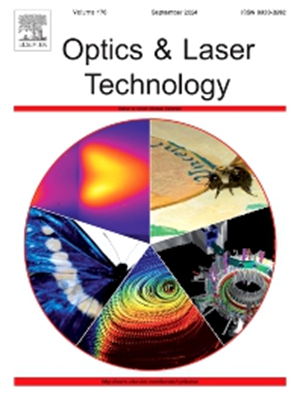Analysis of optical surge impact on gain equalization of FM-EDFA
IF 4.6
2区 物理与天体物理
Q1 OPTICS
引用次数: 0
Abstract
Gain equalization of few-mode erbium-doped fiber amplifiers (FM-EDFAs) determines the power balance of multiple signal channels. For mode-division multiplexed (MDM) optical transmission systems, the optical surge significantly impacts the gain equalization, enlarging the differential modal gain (DMG). In this paper, we investigate the impact of optical surge on the performance of FM-EDFAs through both theory and experiment. The simulation results indicate that in the transient state, the ability to accumulate erbium ions at the 4I13/2 energy level depends on the position within the transverse erbium-doped area, affecting the ability to amplify different modes in fiber due to their unique field distribution. As a result, this phenomenon leads to increased DMG in an FM-EDFA. Besides, both simulation and experiment results verify that the DMG is highly frequency-dependent. Specifically, in our experiment, the DMG is 3 dB at the envelope frequency of 100 Hz, while it is 0.6 dB at 1 MHz. All results provide a guideline for the optimization of FM-EDFAs employed in high-capacity MDM optical communication and sensor systems.

少模掺铒光纤放大器(FM-EDFA)的增益均衡决定了多个信号通道的功率平衡。对于模分复用(MDM)光传输系统,光涌会对增益均衡产生重大影响,扩大差模增益(DMG)。本文通过理论和实验研究了光涌对 FM-EDFA 性能的影响。模拟结果表明,在瞬态下,4I13/2能级的铒离子聚集能力取决于横向掺铒区域内的位置,由于其独特的场分布,会影响光纤中不同模式的放大能力。因此,这种现象导致调频-EDFA 中的 DMG 增加。此外,模拟和实验结果都验证了 DMG 与频率高度相关。具体来说,在我们的实验中,包络频率为 100 Hz 时,DMG 为 3 dB,而在 1 MHz 时,DMG 为 0.6 dB。所有结果都为大容量 MDM 光通信和传感器系统中采用的调频-EDFA 的优化提供了指导。
本文章由计算机程序翻译,如有差异,请以英文原文为准。
求助全文
约1分钟内获得全文
求助全文
来源期刊
CiteScore
8.50
自引率
10.00%
发文量
1060
审稿时长
3.4 months
期刊介绍:
Optics & Laser Technology aims to provide a vehicle for the publication of a broad range of high quality research and review papers in those fields of scientific and engineering research appertaining to the development and application of the technology of optics and lasers. Papers describing original work in these areas are submitted to rigorous refereeing prior to acceptance for publication.
The scope of Optics & Laser Technology encompasses, but is not restricted to, the following areas:
•development in all types of lasers
•developments in optoelectronic devices and photonics
•developments in new photonics and optical concepts
•developments in conventional optics, optical instruments and components
•techniques of optical metrology, including interferometry and optical fibre sensors
•LIDAR and other non-contact optical measurement techniques, including optical methods in heat and fluid flow
•applications of lasers to materials processing, optical NDT display (including holography) and optical communication
•research and development in the field of laser safety including studies of hazards resulting from the applications of lasers (laser safety, hazards of laser fume)
•developments in optical computing and optical information processing
•developments in new optical materials
•developments in new optical characterization methods and techniques
•developments in quantum optics
•developments in light assisted micro and nanofabrication methods and techniques
•developments in nanophotonics and biophotonics
•developments in imaging processing and systems

 求助内容:
求助内容: 应助结果提醒方式:
应助结果提醒方式:


